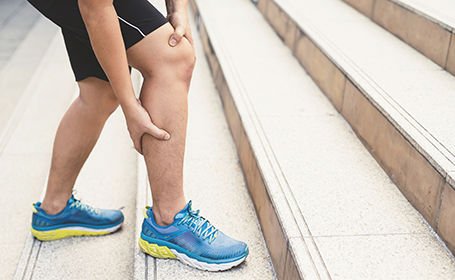
Torn calf muscle
A torn calf muscle, also known as a calf strain or pulled calf, is a common and often painful injury. Find out about the causes, symptoms and available treatments.
What is a torn calf muscle injury?
This type of injury is caused when one of the two muscles in the calf is overstretched or forced to contract too quickly.
It particularly affects people who play sports. Especially sports which require jumping, quick-turn movements or explosive acceleration from a stopped position, such as, squash, tennis, football, rugby and running.
Calf injury appears to be more common as we age. If you tend to work all week remaining relatively inactive, then really push it on the court or pitch at the weekend, unfortunately you’ll be more at risk of tearing your calf muscle.
If you’re experiencing pain from a torn calf muscle, or want to stop it from happening to you, read our guide to the causes, symptoms and treatment.
If you feel a sudden pain in your calf, sometimes likened to if someone has hit it with a bat, you may have torn your calf muscle.
Available treatments for a torn calf muscle
- Physiotherapy
- Sports Injuries Clinic
What are symptoms of a torn calf muscle?
Your calf is made up of two muscles: the gastrocnemius muscle, which is the bigger, ‘meatier’ muscle at the back of the lower leg, and the soleus muscle, which is smaller and positioned lower down in your leg. Both muscles are attached to your heel by the Achilles tendon.
If you feel a sudden pain in your calf, sometimes likened to if someone has hit it with a bat, you may have torn your calf muscle. This pain will build as you continue your activity and there may be obvious swelling and inflammation.
You won’t be able to bear weight on that leg and it may feel stiff or weak, especially first thing in the morning. In some cases the muscle may go into spasm, when the muscles contract tightly and painfully, and bruising may occur.
Usually, calf strains affect the gastrocnemius muscle. If you have strained your soleus muscle you may feel pain lower in your leg and when you push your leg forwards with your knee bent against resistance.
What are the different types of torn calf muscle injuries?
Calf strains can typically be graded into three levels, with most falling into the grade 2 category. Here are the different types:
- Grade 1
A grade 1 calf strain is a small tear that may produce a slight twinge. However it won't normally prevent continued activity. Over time, several small tears could become a more severe injury. - Grade 2
A grade 2 calf strain is a bigger tear which creates a more obvious pain in the lower leg. It is also accompanied by swelling. - Grade 3
A grade 3 calf strain is a complete rupture of the muscle. This would result in severe pain and swelling.
The appropriate course of treatment depends on the severity of your injury.
How to treat a torn calf muscle
Remember to P.R.I.C.E:
- Protection – support the foot and ankle with appropriate shoes.
- Rest – rest your ankle for around 48-72 hours.
- Ice – apply ice for the first 48-72 hours to help reduce swelling. This should be for 15-20 minutes every two to three hours and the ice should not directly touch your skin.
- Compression – this should be snug but not too tight and can help to limit additional movement that could cause further damage.
- Elevation – try to elevate your ankle as much as possible.
The appropriate course of treatment depends on the severity of your injury. If you’ve suffered a minor strain, which is not stopping you from continuing your activity, you may only need to consider targeted strengthening exercises to prevent further, more serious, damage. In more acute cases, you should speak to a healthcare professional.
Here are some things you can do to help manage your injury:
- After giving your muscle appropriate time to rest properly, it’s important to get moving again and to target specific areas to build strength and flexibility. Many of the exercises can be practised at home.
- However, make sure a qualified professional has assessed your individual case. This will ensure the exercises are tailored to you and won’t cause further damage.
- By targeting physiotherapy exercises at your leg you can help to reduce your risk of re-injury, which otherwise may be increased due to scar tissue.
How to prevent a torn calf muscle injury
Some things you can do to help prevent calf strains include:
- Warming up properly before you exercise
- Targeted training to strengthen muscles and improve flexibility
- Making a change to your technique
If you’ve sprained your calf muscle, or want to take steps to build strength and try to prevent future injury, you can contact one of our sports injury clinics. Our team of sports injury specialists know exactly what to look for and can recommend the best techniques to keep you at optimum fitness.
Or you can get in touch with one of our physiotherapists who typically use a combination of manual therapy and exercise to treat injuries.
Tags
How do I book an appointment?
If you're concerned about symptoms you're experiencing or require further information on this subject, talk to a GP or see an expert consultant at your local Circle Hospital.